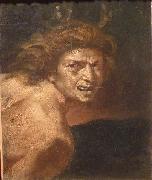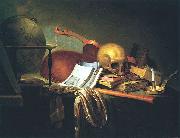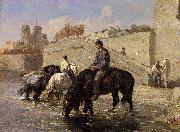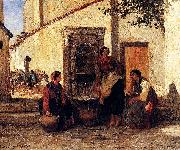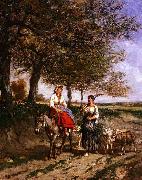Wholesale Oil Painting No Minimum |
|||||||||||
|
|
|||||||||||

|
|||||||||||
|
|
|
||||||||
Henri Felix Emmanuel Philippoteaux(1815-1884) was a French artist. He was born in Paris, France, studied art at the studio of Leon Cogniet,and first exhibited his work at the Paris Salon of 1833. One of his most well-known works was a depiction of the Siege of Paris during the Franco-Prussian War, painted in the form of a cyclorama, a type of large panoramic painting on the inside of a cylindrical platform designed to provide a viewer standing in the middle of the cylinder with a view of the painting. Viewers surrounded by the panoramic image are meant to feel as if they are standing in the midst of a historic event or famous place. Philippoteaux also produced a large number of works chronicling the rise and successes of Napoleon Bonaparte, including a portrait of Napoleon in his regimental uniform and a group of paintings of French victories in the Napoleonic Wars. Philippoteaux was awarded the Legion d'honneur in 1846. Philippoteaux's son Paul Philippoteaux was also an artist; both were famous for their production of cycloramas. Father and son collaborated on The Defence of the Fort d'Issy in 1871. |
||||||||
|
|
||||||||
huile sur toile
huile sur toile Painting ID:: 72023 |
Derniers combats au Pere-Lachaise, 1871, huile sur toile, 51,5 cm x 93,5 cm.
Italiano: Comune di Parigi. Combattimento nel cimitero Pere Lachaise il 27 maggio 1871. Derniers combats au Pere-Lachaise, 1871, huile sur toile, 51,5 cm x 93,5 cm. Italiano: Comune di Parigi. Combattimento nel cimitero Pere Lachaise il 27 maggio 1871. |
|||||||
|
|
||||||||
Eugene DelacroixFrench Romantic Painter, 1798-1863 For 40 years Eugene Delacroix was one of the most prominent and controversial painters in France. Although the intense emotional expressiveness of his work placed the artist squarely in the midst of the general romantic outpouring of European art, he always remained an individual phenomenon and did not create a school. As a personality and as a painter, he was admired by the impressionists, postimpressionists, and symbolists who came after him. Born on April 28, 1798, at Charenton-Saint-Maurice, the son of an important public official, Delacroix grew up in comfortable upper-middle-class circumstances in spite of the troubled times. He received a good classical education at the Lycee Imperial. He entered the studio of Pierre Narcisse Guerin in 1815, where he met Theodore Gericaul |
||||||||
|
|
||||||||
|
|
Huile sur toile
Huile sur toile Painting ID:: 75298 |
Don de Horace de Choiseul (1866)
Date 1825
cyf Don de Horace de Choiseul (1866) Date 1825 cyf |
||||||
|
|
||||||||
|
|
||||||||
|
|
Huile sur toile
Huile sur toile Painting ID:: 78225 |
Huile sur toile
74,5 x 96,5 cm
cjr
Huile sur toile 74,5 x 96,5 cm cjr |
||||||
|
|
||||||||
James Joseph Jacques TissotJames Jacques Joseph Tissot (15 October 1836 - 8 August 1902) was a French painter, who spent much of his career in Britain. Tissot was born in Nantes, France. In about 1856, he began study at the École des Beaux-Arts in Paris under Hippolyte Flandrin and Lamothe, and became friendly with Edgar Degas and James Abbott McNeill Whistler. Tissot exhibited in the Paris Salon for the first time in 1859, two portraits of women and three scenes in medieval dress from Faust. The latter show the influence of the Belgian painter Henri Leys (Jan August Hendrik Leys), whom he had met in Antwerp in 1859. In the mid-1860s, however, Tissot began to concentrate on depicting women, often although not always shown in modern dress. Like contemporaries such as Alfred Stevens and Claude Monet, Tissot also explored japonisme, including Japanese objects and costumes in his pictures. A portrait of Tissot by Degas from these years (Metropolitan Museum of Art, New York) shows him with a Japanese screen hanging on the wall. |
||||||||
|
|
||||||||
|
|
Huile sur toile
Huile sur toile Painting ID:: 85443 |
oil on canvas
cyf oil on canvas cyf |
||||||
|
|
||||||||
James Joseph Jacques TissotJames Jacques Joseph Tissot (15 October 1836 - 8 August 1902) was a French painter, who spent much of his career in Britain. Tissot was born in Nantes, France. In about 1856, he began study at the École des Beaux-Arts in Paris under Hippolyte Flandrin and Lamothe, and became friendly with Edgar Degas and James Abbott McNeill Whistler. Tissot exhibited in the Paris Salon for the first time in 1859, two portraits of women and three scenes in medieval dress from Faust. The latter show the influence of the Belgian painter Henri Leys (Jan August Hendrik Leys), whom he had met in Antwerp in 1859. In the mid-1860s, however, Tissot began to concentrate on depicting women, often although not always shown in modern dress. Like contemporaries such as Alfred Stevens and Claude Monet, Tissot also explored japonisme, including Japanese objects and costumes in his pictures. A portrait of Tissot by Degas from these years (Metropolitan Museum of Art, New York) shows him with a Japanese screen hanging on the wall. |
||||||||
|
|
||||||||
|
|
Huile sur toile
Huile sur toile Painting ID:: 85543 |
oil on canvas
cyf oil on canvas cyf |
||||||
|
|
||||||||
Leon-Jules Lemaitrepainted Le Pont Corneille, Rouen in 1890 |
||||||||
|
|
||||||||
|
|
Huile sur toile
Huile sur toile Painting ID:: 97119 |
oil on canvas
cyf oil on canvas cyf |
||||||
|
|
||||||||
|
Leon-Jules Lemaitre painted Le Pont Corneille, Rouen in 1890 Huile sur toile oil on canvas cyf |
||||||||
|
|
||||||||
|
Prev Next
|
||||||||
|
|
||||||||
|
Related Paintings to Leon-Jules Lemaitre :. |
||||||||
|
|
||||||||
|
CONTACT US |


